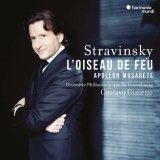Diese neue Einspielung des gesamten Balletts L’Oiseau de Feu durch Gustavo Gimeno und das herausragend gut spielende Philharmonische Orchester Luxemburg ist sehr atmosphärisch und märchenhaft. Gimeno kostet die Musik liebevoll und mit zartfühlender Hand aus. Im ersten Teil des ersten Tableaus hat man den Eindruck, musikalisch entführt zu werden, man lässt sich einhüllen, gepackt nur von der Magie der Musik, in der Figuren und Pflanzen im Zauberharten akustisch sichtbar werden. Und wenn die Musik auch manchmal dramatischer wird, so bleibt sie immer magisch stimmungsvoll, hat aber in der Danse infernale die nötige orchestrale Kraft, um den Hörer auch durch sie zu fesseln. Und ehe die Ballettmusik in üppiger Pracht endet, wird Kastschais Todesszene und die Ausbreitung von tiefer Dunkelheit sehr spannungsvoll geschildert.
Der großartige Eindruck dieser Aufnahme wird verstärkt durch eine exzellente Tonaufnahme, deren Klang den Eindruck, man werde von der Musik erfasst, nur verstärkt.
Für Apollon Musagète holte sich Stravinsky eine Vorlage in der Antike. Die Ballettmusik entstand nicht, wie im Falle von L’Oiseau de Feu, für Diaghilev, sondern für eine amerikanische Truppe. Expressivität und theatralischer Formaufbau sind die Hauptmerkmale des Balletts, das die Streicher des Philharmonischen Orchesters Luxemburg gut herüberbringen. Sie spielen elegant und mit fein dosierte Expressivität so dass Apoll als Liebling der Musen erkennbar wird. Dennoch bleibt Gimeno, darin Karajan nicht unähnlich, abstrakt und irgendwie auch mystisch, nicht so handlungsbezogen etwa wie Simon Rattle.
This new recording of the complete ballet L’Oiseau de Feu by Gustavo Gimeno and the outstandingly well playing Luxembourg Philharmonic Orchestra is very atmospheric and fairytale-like. Gimeno savors the music lovingly and with a delicate hand. In the first part of the first tableau, one has the impression of being musically swept away by the magic of the music, in which figures and plants become acoustically visible in the magic hard. And even if the music sometimes becomes more dramatic, it always remains magically atmospheric, but in the Danse infernale it has the necessary orchestral power to captivate the listener that way too. And before the ballet music ends in lush splendor, Kastschai’s death scene and the spread of deep darkness are pictured with great suspense.
The great impression of this recording is reinforced by an excellent sound recording whose sound only enhances the impression of being gripped by the music.
For Apollon Musagète, Stravinsky took a model in antiquity. The ballet music was not written for Diaghilev, as in the case of L’Oiseau de Feu, but for an American troupe. Expressivity and theatrical formal structure are the main features of the ballet, which the strings of the Luxembourg Philharmonic Orchestra bring across well. They play elegantly and with finely dosed expressivity characterizing Apollo as the favorite of the Muses. Nevertheless, Gimeno, not unlike Karajan in this, remains quite abstract and somehow mystical, not as action-oriented as, say, Simon Rattle.
























